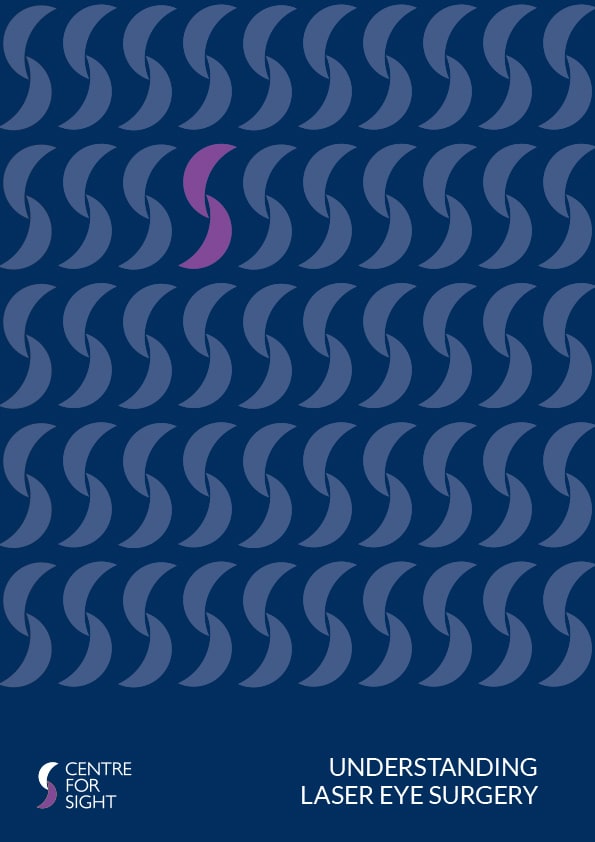LASIK / IntraLASIK
Centre for Sight introduced IntraLASIK surgery to the UK in 2004. IntraLASIK laser eye surgery is the safest, most precise vision correction option with the longest track record available in the world today.
What is LASIK eye surgery?
LASIK (laser in situ keratomileusis) is a laser vision correction technique that has been in use for over 20 years (since 1989). An excimer laser is used to reshape the cornea and correct a wide range of nearsightedness, farsightedness, astigmatism and now presbyopia (the need for reading glasses) using Supracor LASIK.
First the Intralase femtosecond laser is used to create a thin flap on the cornea. This takes about 15 seconds. Next an Excimer laser pre-programmed by your surgeon applies a cool ultraviolet laser light which changes the shape of the front of the cornea. The change in the curvature of the cornea performed in a very precise manner allows images to come to sharp focus on your retina. Once this is complete, the flap is then smoothed back into place where it quickly bonds through normal healing.
- IntraLASIK is much safer with precision flaps and no blade related complications
- Wider range of correction possible
- Shortsight upto -12.00 diopters (in special cases)
- Longsight upto +5.00 diopters (even more in special circumstances)
- Astigmatism upto 5 diopters – possibly more using Centre for Sight designed software
- Presbyopia – need for reading glasses can be corrected using Supracor LASIK
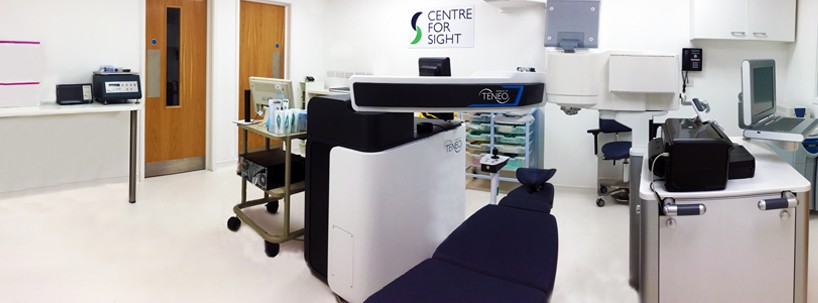
IntraLASIK eye surgery
The procedure
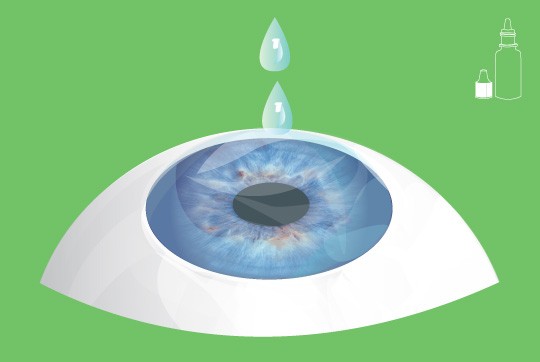
You are given a sedative to help you relax. Strong anaesthetic drops numb your eyes beforehand. Antibiotic drops are used to prevent infection.
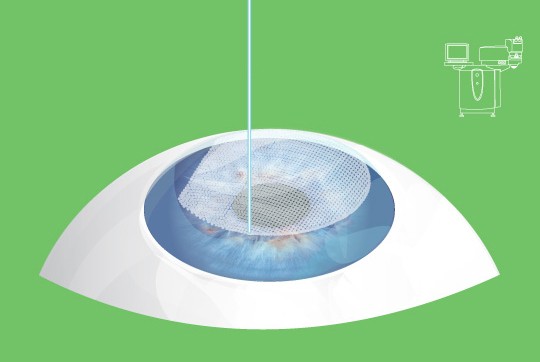
The IntraLase Femtosecond Laser is used to create thousands of tiny bubbles to precisely separate a corneal flap at a specified depth in the cornea.
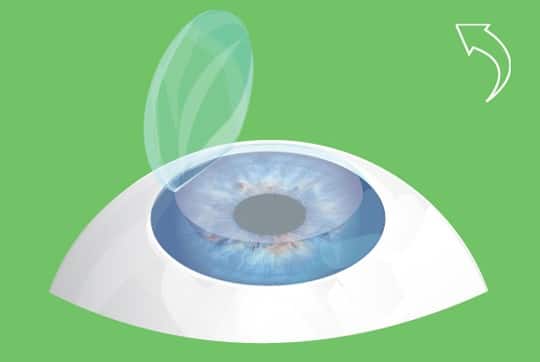
The flap is then carefully lifted.
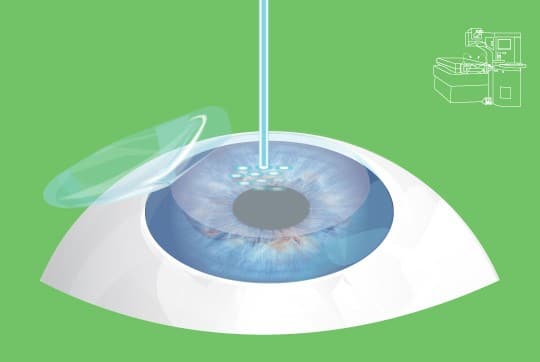
The Bausch + Lomb-Technolas Excimer Laser is used to reshape the inner cornea, customised to each individual eye from preoperative tests including wavefront evaluation and topography.
Iris recognition technology fixes and tracks alignment of the laser in multiple dimensions. This ensures delivery is absolutely precise and you do not have to worry if your eyes move! (The technology has the added benefit of confirming the correct treatment is being applied to the correct eye!)
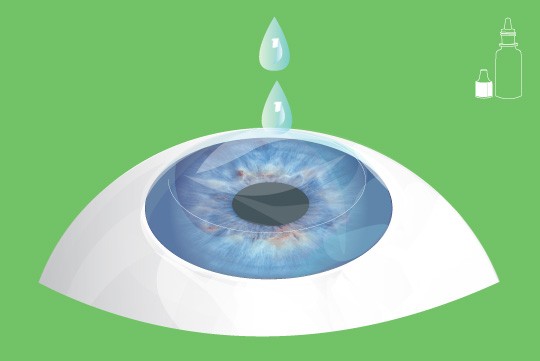
When the treatment is complete the flap is replaced and allowed to dry. The flap attaches without the need for stiches and more eye drops are administered to prevent infection and avoid discomfort.
All patients at Centre for Sight undergo IntraLASIK eye surgery – No compromise
In traditional LASIK surgery, a mechanical microkeratome with a surgical blade is used by the surgeon to cut a tiny-hinged flap of tissue. Since its introduction in 1989, the design of the microkeratome has seen very little advancement. Centre for Sight surgeons previously performed thousands of LASIK treatments with this traditional method, but keeping to its ethos of safety first, in 2004 blade keratomes were abandoned in favour of the safer option – IntraLASE surgery. It took two years before other providers followed the Centre for Sight lead and acquired the technology.
To eliminate complications attributed to the blade microkeratome, ALL patients undergoing LASIK surgery at Centre for Sight are undergoing IntraLASIK – no compromise! Some centres will “upsell” use of Intralase over the microkeratome. Our philosophy is to ensure patients get the absolute best – so why offer a technique that is in any way deficient?
IntraLASIK is derived from the laser IntraLASE, a femtosecond laser first commercially available for creating corneal flaps for Lasik in 2002 (USA) and 2004 (Europe). Centre for Sight acquired the first laser in the UK in 2004 and was amongst the first 10 in Europe.
Am I a candidate suitable for LASIK surgery / IntraLASIK surgery?
To find out about your suitability for Lasik/IntraLASIK surgery, please use the Am I Suitable questionnaire. Answer a few simple questions and our staff will contact you back with more information about suitable options. The final decision about your suitability for this procedureLasik/IntraLASIK surgery will depend on findings by the consultant surgeon at your consultation. A very thorough 2 to 3 hour consultation with a clearly defined patient care pathway involving numerous investigative tests followed by a complete eye examination by your surgeon will determine if you are a candidate. Not everyone unfortunately is suitable for LASIK/IntraLASIK surgery, however there are some basic requirements:
- Over 18 years old
- Stable spectacle prescription of at least 6/12 (20/40)
- Healthy cornea
- Not pregnant or nursing
- No autoimmune diseases
Understanding Laser Eye Surgery brochure
An overview of the ground-breaking laser eye procedure performed at Centre for Sight along with FAQ which will take you step-by-step through everything you need to know.
Get in touch and we will post one out to you. Call 0800 0112882 or email enquiries@centreforsight.com
Advantages IntraLASIK eye surgery
“Flaps heal more strongly and quickly”
- The IntraLase iFS eliminates all blade related complications attributed to the mechanical blade keratome.
- Computer controlled accuracy of the IntraLase iFS creates a precise cornea resection withgreater consistency of flap thickness. If you were not a candidate for traditional LASIK surgery, you may still be a candidate for the IntraLASIK procedure.
- The long wavelength of the IntraLase iFS laser creates precision flaps without heating or damaging surrounding tissue.
“IntraLASIK surgery results in less symptoms of dry eye”
- The precision shape of the flap allows it to settle back with a tighter seal.
- IntraLASIK flaps heal more strongly and quickly.
- IntraLASIK flaps result in less symptoms of dry eye.
IntraLASIK Consultation and Pre-op LASIK surgery
A successful LASIK eye surgery begins with a thorough patient consultation with numerous supporting investigations. As this is considered so important, all consultations at Centre for Sight are performed by a Fellowship trained consultant – no compromise.
During consultation, general information will be gathered about your eyes. Information will also be sought about your lifestyle: your history of glasses and contact lens wear, physical activities you participate in, your visual needs and how you expect your life to change after LASIK eye surgery.
“All our consultations are performed by a surgeon, no compromise!”
The results of your consultation will be discussed with you and you will have the opportunity to have any questions answered by one of our fellowship-trained consultants. Your suitability for IntraLASIK / LASIK surgery and alternative vision corrective treatments suitable for you will be discussed.
Your tests
Your consultation with us is arguably the most comprehensive eye examination you will ever have. It does take a while to be thorough so we suggest you allow 2-3 hours for its completion. To confirm the exact refractive error in your eyes and determine the best available treatment specifically for you, our Fellowship-trained consultants and technicians will examine and perform tests on your eyes:
- Your eyes will be refracted initially to check what power your eyes require for full and perfect correction.
- Corneal topography equipment is used to map out the surface of your eyes. The corneal topography equipment measures the contour of your cornea in 3 Dimensions. Further OCT scanning may be required depending on preliminary findings. OCT scanning is used to measure the distribution of your corneal epithelium. It is also used to check your optic nerve and macula.
- Wavefront Aberrometry will also be performed to determine if you have any high-order aberrations that might be affecting visual quality and any night vision troubles.
- Corneal pachymetry measures the thickness of the cornea.
- The Ocular Response Analyser (ORA) is used to determine the elasticity of your cornea prior to laser eye surgery.
- Dry eye tests are also performed. Should there be any significant findings, specific treatment will be suggested prior to your procedure.
- Your eyes will be dilated to check the back of your eye, as a result you will not be able to drive after your consultation.
- Additional tests may be required depending on findings at consultation.
This information is valuable in performing IntraLASIK / LASIK eye surgery and is used by your consultant to determine the best treatment option available for each individual eye.
For more details about the consultation process click here.
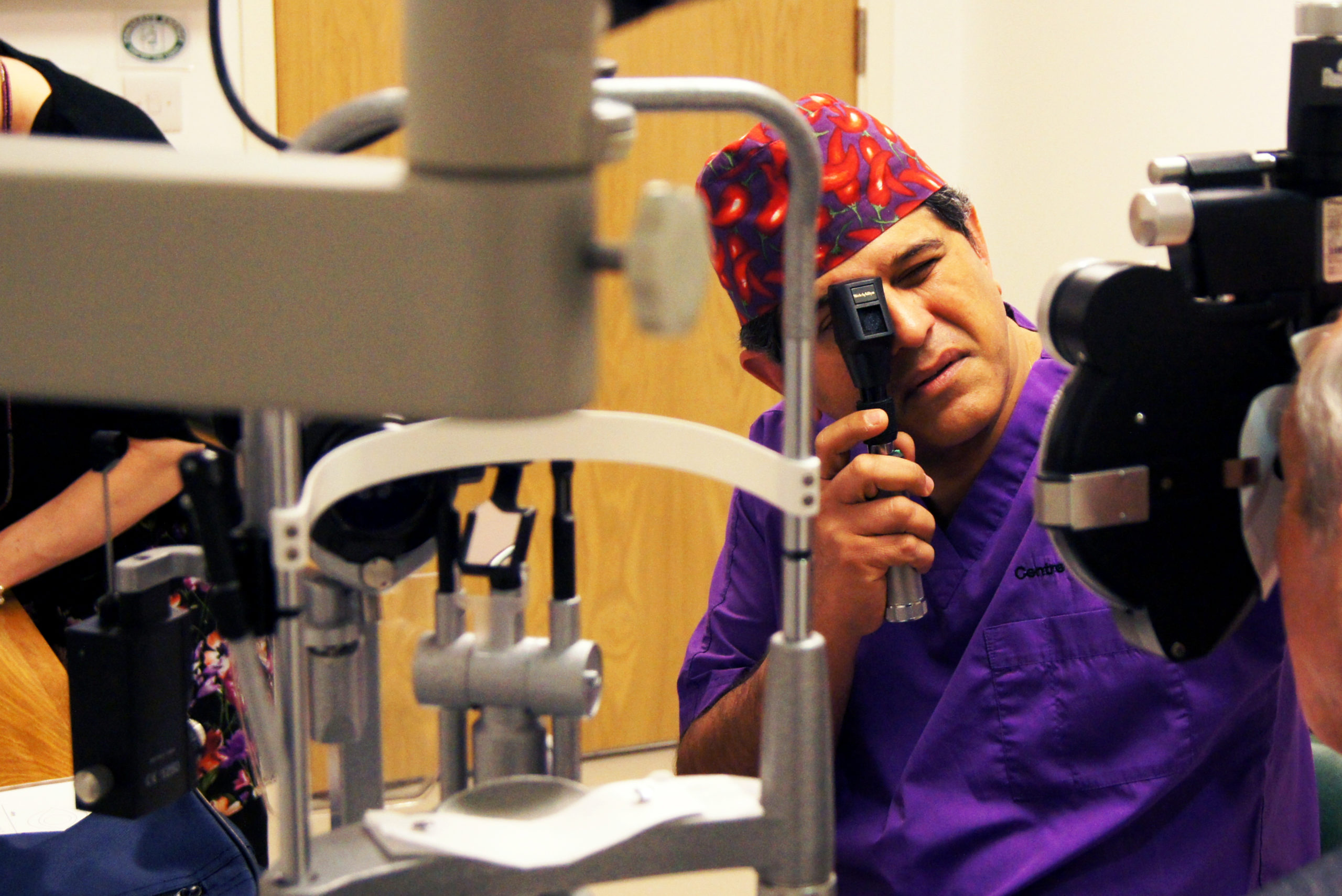
The LASIK and IntraLASIK Procedure
Prior to each procedure, “pre-flight” checks are performed by the surgeons and technicians well before the first patient arrives. To ensure consistently phenomenal outcomes, Centre for Sight standards far exceed the minimum requirement. For instance although not necessary, the laser is calibrated immediately prior to each patient treatment.
On the day of your surgery, dress comfortably and avoid any clothes that are tight fitting or shed fibres.
IntraLASIK surgery Step by Step:
- You are given a mild oral sedative to help you relax and make you less anxious. After your eye has been numbed with anaesthetic eye drops, the Consultant gently places an eyelid clip to hold your eyelids open. You will remain awake and comfortable throughout the procedure.
- Your surgeon will then begin the first step of any LASIK procedure by creating a corneal flap. The IntraLase FS laser is to create the flaps in both eyes.
- The laser bed will be rotated to the Excimer laser. IRIS recognition is performed to recognize and track the eye.
- The flap will be gently lifted from the centre of the cornea to allow the excimer laser access to the underlying tissue.
- To begin the second step of the IntraLASIK procedure, your surgeon will ask you to look at a target flashing red light. The cool light of the excimer laser will reshape the corneal tissue, correcting your vision as you look at this light. You will hear clicking sounds as a microscopic layer of tissue is vaporized and the iris recognition and registration eye tracker ensures accurate placement of each laser pulse. This process will last from a few seconds to a minute, depending on the amount of correction necessary.
- When the procedure is complete, your surgeon will meticulously replace the corneal flap and gently smooth it into place.
- You will then recover in a reclining chair for 15 to 20 minutes and then your vision will be checked. Your eye surgeon will check your eyes to make sure all is well before you go home.
- You will be given eye drops, and instructed in their use.
Directly after LASIK/IntraLASIK surgery:
- You may notice that your vision will be a little blurry immediately following your LASIK /IntraLASIK surgery. This blurriness will gradually clear in the next few hours. You might even get the sensation that you have soap in your eyes for a couple of hours.
- Someone will need to drive you home and we suggest you go to sleep for the next 4 hours after putting in the first dose of your eye drops.
- After 4 hours, you may watch TV or read as long as you take your eye drops as well as lubricant drops frequently every five to ten minutes.
- It is important to avoid wind or any type of air turbulence that would cause your eyes to dry out.
Follow up care after LASIK surgery or IntraLASIK surgery
Follow up care is vital for good outcomes and we at Centre for Sight like to see our patients ideally the following day or at least within a few days of the procedure. Our staff will call you the night of the procedure and then next day if you are unable to attend for follow up.
- You will be provided with eye drops and protective eyewear. Please follow the instructions provided.
- By the first post-op visit, most patients are able to drive themselves to their appointment. Most patients are excited about their vision the following day and most see 20/25 (6/7.5) or better.
- Following LASIK surgery, your vision improves very rapidly, allowing you to return to work within a day or two after you have had the procedure.
Common questions about LASIK / IntraLASIK surgery
You will need to be seen the next day or a few days after the initial procedure. You will then be seen at 1 month and again at 6 months for a final visit. Sometimes patients are seen at 3 months if there are concerns about regression or if there is a possibility that an enhancement treatment may be needed. More frequent appointments may be scheduled if needed. Our surgeons at Centre for Sight are available to see you whenever necessary and a helpline is available 24/7.
- Showering.- NEXT DAY – with eyes closed
- Driving.- When you feel comfortable with your vision and are able to meet the visual requirement for driving (number plate at 25 yards). The majority of patients are able to accomplish this the next day.
- Flying.- SAME DAY of the procedure. You may need artificial tears if taking a long-haul flight.
- Exercise.- Moderate Right away Heavy After 10 Days
- Swimming.- 4 weeks
- Diving.- 6 weeks
- Eye make-up.- Mascara 4 weeks – the wand can accidentally hit your corneal flap which will not be felt as the surface will be a little numb. Consider eyelash tinting before the procedure. Other 2 days – taking care to remove gently without much pressure on the eye
There is no real top age for LASIK/IntraLASIK surgery. A thorough eye examination is important to ensure that any visual problem is not caused by other problems such as cataracts or glaucoma. In certain age groups (>55) we prefer to consider Laser Lens Exchange over LASIK/IntraLASIK as this is a permanent correction that has the potential to provide a full range of correction and eliminate the need for all glasses including reading glasses altogether.
Presbyopia is a condition where reading glasses are required. This occurs because the lens inside the eye becomes harder and can no longer change shape to focus sufficiently. Those with this condition need reading glasses. There are options for correcting this condition using lasers and the treatment is called “Supracor”. Supracor surgery corrects both eyes for both distance and near. An alternative treatment is Monovision or blended vision where the dominant or leading eye is treated for distance and other non-dominant eye for near. The options for correction will depend on the eye and your surgeon will illustrate what is the best option for you.
The procedure has been in use for over 20 years and is approved by the USA’s stringent Food and Drug Administration (FDA). The procedure is also approved by the UK’s National Institute of Clinical Excellence (NICE). The outcomes and safety of the procedure is highly dependent on the Surgeon, the centre and its processes and environment as well as technology.
No. The treatment itself is completely painless. Large amounts of anaesthetic drops are used which completely numb the eye. You might feel a bit of pressure at the very beginning when the Intralase laser is used to create the front flap. After the procedure some patients describe a gritty sensation like a lash in their eye. Some feel a bit of stinging and this lasts for a few hours. For this reason we ask patients to have a nap for about 4 hours after the procedure. Paracetamol or Advil is the most you will need to manage the discomfort.
LASIK/IntraLASIK surgery is very quick and usually takes less than 10 minutes per eye. Although the procedure is quick, plan on being at the centre for about 2 to 3 hours as time is required to prepare you, perform the treatment, and allow you to recover and be discharged.
Based on our clinical data and audit as well that of regulatory authorities like the FDA, Lasik/IntraLASIK surgery is highly accurate. We take treatments very seriously and go through considerable care to ensure accuracy of correction. 98% of patients undergoing correction for shortsight obtain 20/20 (6/6) vision and 85% 20/25 (6/5). In spite of advanced technology and attention to detail, a small number of patients do require a touch-up or enhancement to achieve good unaided vision. This is because everyone responds differently and there is some variation in how people respond and heal. We are very proud to have a very low enhancement rate at less than 1%.
Contact lenses – yes even soft ones, can alter the corneal shape. Our rule of thumb is for soft lens wearers, you need to be out of them for ONE week before your evaluation. For hard lenses, 4 weeks is best. After the consultation and before your surgery, if you can avoid wearing lenses that will be best. If you do have to wear lenses, we suggest you discontinue soft contact lenses for at least 2 days before your procedure. For hard lenses, you may be asked to leave them out until the day of your procedure.
I understand that all my data, clinical and otherwise will be protected under GDPR. I understand my data may used for the purposes of quality improvement and advancement of eye care such as audit. This is a component of good clinical governance and measures will be taken to ensure my data is not identifiable.

